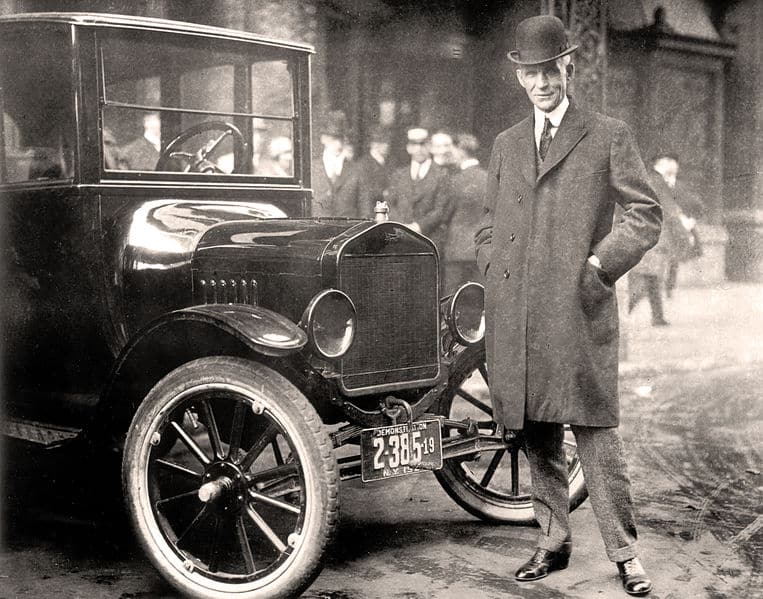What Would Henry Ford Think of Cuts in Ford Lightning EV Production?
In January 2024, media reports once again cited softening EV demand as the reason for companies such as Ford to decide to cut EV production. Ford announced a reduction in production of its F-150 Lightning pickup truck in response to a lower-than-expected demand for electric vehicles (EVs). The No. 2 U.S. automaker has decided to cut the production at its Michigan Rouge Electric Vehicle Center to a single shift starting April 1. This decision comes in the wake of their previous statement in October, where the automaker revealed its plan to temporarily cut one of three shifts at the Michigan plant that manufactures the electric F-150 Lightning pickup truck.
“We are taking advantage of our manufacturing flexibility to offer customers choices while balancing our growth and profitability,” said Ford CEO Jim Farley.
General Motors, in a similar vein, postponed the opening of a $4 billion electric truck plant in Michigan for a year in October. Further adding to the growing evidence of underwhelming EV truck demand, Ford communicated to its suppliers in December that it planned to produce about 1,600 F-150 Lightning EV trucks per week starting in January. This figure is significantly lower, being roughly half of the 3,200 trucks it previously planned to manufacture on a weekly basis. The overall scenario indicates a recalibration of production strategies in response to the evolving market dynamics in the EV segment.

Despite the recalibration, Ford managed to sell 24,165 F-150 Lightning trucks in 2021 in the United States, marking a 55% increase over 2022. This was out of about 750,000 total F-150 U.S. sales. In August, Ford had communicated that the plant manufacturing the F-150 Lightning could reach a 150,000-vehicle annualized production rate by October. This came after the automaker’s declaration in 2022 about doubling its EV truck production. The Dearborn-based automaker announced plans to add a third crew and create almost 900 jobs at its Michigan assembly plant. This move aims to increase the production of gas-powered Bronco SUVs and Ranger pickups.
The F-150 Lightning production cut comes at a time when Detroit automakers are protesting that the Biden Administration is going too far with proposals to use emissions rules that would result in 67% of all new vehicles in 2032 being EVs. The Environmental Protection Agency (EPA) submitted its proposal to finalize vehicle requirements to the White House for review. In December, the Republican-led U.S. House voted to bar the EPA from moving forward with the planned vehicle emissions regulations, drawing a veto threat from the White House.
Ford announced that the production changes would affect approximately 1,400 employees at the plant. Roughly half of these workers, around 700, will be reassigned to the Michigan Assembly Plant. Others will be placed in various roles at the Rouge Complex or other Michigan-based facilities, or they may opt to participate in a special retirement program. Despite the recalibration, Ford foresees a continued increase in global EV sales through 2024, albeit potentially less robust than initially anticipated. The automaker also indicated that a small number of employees, possibly in the dozens, could be affected at component plants supporting F-150 Lightning production.
Ford revealed a significant loss in their electric vehicle (EV) sector during the third quarter of the year. With each of the 36,000 EVs delivered to dealers, the company reported an estimated loss of $36,000. This announcement came in October, shortly after Ford declared its intention to decelerate the expansion of its loss-making EV segment. Instead, the corporation has decided to reallocate its investments towards the commercial vehicle unit, with plans to multiply the sales of gas-electric hybrids by four within the next five years. Traditional automakers have gradually shifted their attention to hybrid models over the past year, a strategic move prompted by the increasing consumer preference for hybrids over entirely electric models. Would Ford’s founder, Henry Ford, agree with these decisions?
Henry Ford, the Founder of Ford Motor Company
Henry Ford, the founder of Ford Motor Company, was the first to manufacture an automobile that was affordable for middle-class Americans. His conversion of the automobile from an expensive luxury into an accessible conveyance profoundly affected many aspects of life in the 20th century.
Ford revolutionized the automobile industry by introducing large-scale manufacturing methods and industrial workforce management strategies. The hallmark of this transformative approach was a meticulously devised sequence of manufacturing steps, epitomized by the moving assembly line. By 1914, Ford’s novel, efficient methods, later termed ‘Fordism,’ had gained worldwide recognition. This brought about a radical shift in the manufacturing landscape, setting new standards for production efficiency and workforce management.

Ford Motor Company’s Model T Killed EVs
In the early 1900s, electric vehicles were in their prime, representing approximately one-third of all vehicles on the road. Their popularity soared over the next decade, with sales remaining robust. However, the inception of Henry Ford’s mass-produced Model T in 1908 marked a turning point in the automotive industry. This vehicle made gasoline-powered cars not just ubiquitous but also economically viable for the average individual. By 1912, the stark contrast in cost was evident: a gasoline car came with a modest price tag of $650, whereas an electric roadster was significantly more expensive, retailing at $1,750. Consequently, the Model T played a pivotal role in the decline of the electric car, reshaping the automotive landscape.
What Would Henry Ford Think of the Ford Lightning EV Cutbacks?
Like the Ford Lightning, The Model T didn’t make profit initially. Henry Ford invested heavily in the large-scale manufacturing methods that made the Model T possible and affordable, killing the EV revolution as it was just getting started. Today, in 2024, the EV revolution has been resurrected; it is in full swing globally. In 2024, Rivian’s R1T, Chevy’s Silverado EV, GMC’s Hummer EV Pickup, and Ram’s 1500 REV, among others, will gladly take EV pickup truck market share from Ford, due to the cutbacks in Lightning production. Henry Ford would have directed Jim Farley not to cut Lightning production, in our opinion.
Pickup Trucks are Important in the EV Revolution
Projected to hit the two million mark in new pickup truck sales in 2023, the United States reiterates its unbroken bond with these full-size vehicles. More than just a tool of utility, these trucks have come to represent an identity deeply rooted in American values — an embodiment of strength, liberty, and individualism. Across the nation, they stand as symbols of the tough and free spirit that defines the American way of life. The surging demand and sales figures bear testimony to their unyielding resonance with the American ethos. Transcending their practical usage, pickup trucks have evolved into a cultural icon that narrates tales of capability and the spirit of adventure. EV makers are capitalizing on this love of pickup trucks in America. Ford should rethink its cutbacks to Lightning production. As any good investor will tell you, it takes money to make money. Risk pays off.
More EV Education is Vital
The reason why Ford and other OEMs are cutting back on EV production is that American consumers are largely unfamiliar with EVs. The early adopters have purchased EVs already. We’re now in the early marjority segment of EV adoption, a much more pragmatic and tougher audience to sell EVs to. Education, both formal and informal, plays a pivotal role in overcoming the barriers to electric vehicle (EV) adoption. In order to enhance comfort and familiarity with EVs, we need to leverage educational platforms to disseminate information about the technology, its benefits, and its operation. This includes educating the public about how electric vehicles work, how they’re charged, their range capabilities, and the economic advantages like potential savings from lower off-peak utility rates. Additionally, alleviating range anxiety through knowledge about the expanding EV charging infrastructure can also boost consumer confidence. Furthermore, real-world testimonials from EV owners can be an effective educational tool, as they are often the most enthusiastic promoters of this technology. There’s a significant opportunity for growth here, with less than 10% of Americans being very familiar with EVs. By capitalizing on this opportunity through dedicated education programs and utilizing available federal funding, we can expedite the widespread adoption of EVs in our communities.

Electric Vehicle Marketing Consultant, Writer and Editor. Publisher EVinfo.net.
Services